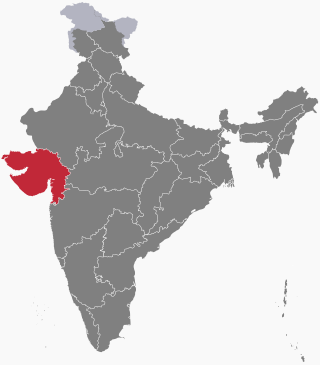Related Research Articles

Sind was a province of British India from 1 April 1936 to 1947 and Dominion of Pakistan from 14 August 1947 to 14 October 1955. Under the British, it encompassed the current territorial limits excluding the princely state of Khairpur. Its capital was Karachi. After Pakistan's creation, the province lost the city of Karachi, as it became the capital of the newly created country. It became part of West Pakistan upon the creation of the One Unit Scheme.

India is a federal union comprising 28 states and 8 union territories, for a total of 36 entities. The states and union territories are further subdivided into districts and smaller administrative divisions.

Bombay State was a large Indian state created in 1950 from the erstwhile Bombay Presidency, with other regions being added to it in the succeeding years. Bombay Presidency was merged with the princely states of Baroda, Western India and Maharashtra State. Current Madhya Pradesh was a Central and Berar province, which was historically a Marathi state but hindinized later.

The Bombay Presidency or Bombay Province, also called Bombay and Sind (1843–1936), was an administrative subdivision (province) of British India and later the Dominion of India, with its capital in the city that came up over the seven islands of Bombay. The first mainland territory was acquired in the Konkan region with the Treaty of Bassein (1802). Poona was the summer capital.
Shah Nawaz Bhutto, was a politician and a member of Bhutto family hailing from Larkana in the Sind region of the Bombay Presidency of British India, which is now Sindh, Pakistan.

Ganesh Vasudev Mavalankar popularly known as Dadasaheb was an independence activist, the President of the Central Legislative Assembly, then Speaker of the Constituent Assembly of India, and later the first Speaker of the Lok Sabha, the lower house of the Parliament of India. His son Purushottam Mavalankar was later elected to the Lok Sabha twice from Gujarat.

The provinces of India, earlier presidencies of British India and still earlier, presidency towns, were the administrative divisions of British governance on the Indian subcontinent. Collectively, they have been called British India. In one form or another, they existed between 1612 and 1947, conventionally divided into three historical periods:

An agency of British India was an internally autonomous or semi-autonomous unit of British India whose external affairs were governed by an agent designated by the Viceroy of India.
Bombay Legislative Council was the legislature of the Bombay Province and later the upper house of the bicameral legislature of Bombay Province in British India and the Indian state of Bombay.

Provincial elections were held in British India in the winter of 1936-37 as mandated by the Government of India Act 1935. Elections were held in eleven provinces - Madras, Central Provinces, Bihar, Orissa, the United Provinces, the Bombay Presidency, Assam, the North-West Frontier Province, Bengal, Punjab and Sind.
The elections to the two houses of legislatures of the Bombay Presidency were held in 1937, as part of the nationwide provincial elections in British India. The Indian National Congress was the single largest party by winning 86 of 175 seats in the Legislative Assembly and 13 of 60 seats in the Legislative Council.
Although a parliamentary democracy, Indian politics has increasingly become dynastic, possibly due to the absence of a party organization, independent civil society associations that mobilize support for the party, and centralized financing of elections. Family members have also led the Congress party for most of the period since 1978 when Indira Gandhi floated the then Congress(I) faction of the party. It also is fairly common in many political parties in Maharashtra. The dynastic phenomenon is seen from national level down to district level and even village level.The three-tier structure of Panchayati Raj established in the 1960s also helped to create and consolidate the dynastic phenomenon in rural areas. Apart from government,political families also control cooperative institutions, mainly cooperative sugar factories,district cooperative banks in the state, and since the 1980s private for profit colleges. The ruling Bharatiya Janata Party also features several senior leaders who are dynasts. In Maharashtra, the NCP has particularly high level of dynasticism.
Santalpur is a village in Santalpur Taluka of Patan district of Gujarat state, India.
Varahi is a village in Santalpur taluka of Patan district of Gujarat state of India.
Tervada is a village in Kankrej Taluka of Banaskantha district in Gujarat, India.
Bhabhar is a town in the Banaskantha district of Gujarat, India.

The following outline is an overview of and topical guide to the state of Gujarat in Western India, sometimes called the "Jewel of Western India". It has an area of 196,024 km2 (75,685 sq mi) with a coastline of 1,600 km (990 mi), most of which lies on the Kathiawar peninsula, and a population in excess of 60 million. It is bordered by Rajasthan to the north, Maharashtra to the south, Madhya Pradesh to the east, and the Arabian Sea and the Pakistani province of Sindh to the west. Its capital city is Gandhinagar, and its largest city is Ahmedabad. Gujarat is home to the Gujarati-speaking people of India.
References
- ↑ The Bombay Legislative Assembly Manual printed by Bombay (Presidency). Legislative assembly - 1937
- ↑ Maharashtra Legislative Assembly, 50 Years (1937-87): Its Genesis, Growth, and Work by S. H. Belavadi Maharashtra Legislature Secretariat, 1988
- 1 2 Natesan, G. A. (1937). The Indian review, Volume 38. G.A. Natesan & Co. p. 151.
- ↑ Khairmode, Changdev Bhawanrao (1985). Dr. Bhimrao Ramji Ambedkar (Vol. 7) (in Marathi). Mumbai: Maharashtra Rajya Sahilya Sanskruti Mandal, Matralaya. p. 245.
- ↑ Jaffrelot, Christophe (2005). Dr Ambedkar and Untouchability: Analysing and Fighting Caste. London: C. Hurst & Co. Publishers. pp. 76–77. ISBN 978-1850654490.
- ↑ Reed, Stanley (1937). The Times of India Directory and Year Book Including Who's who. Bennett, Coleman & Company.